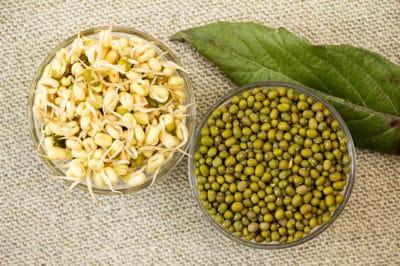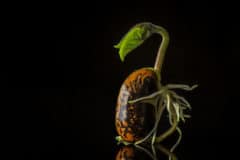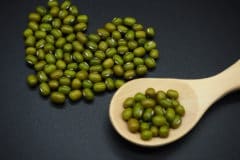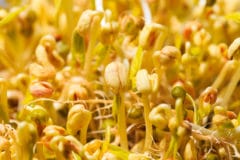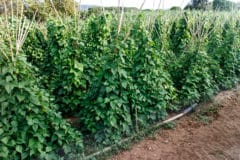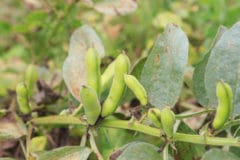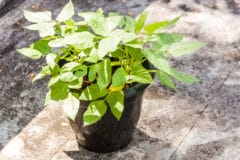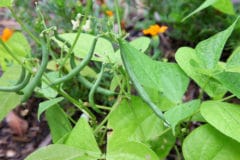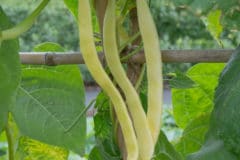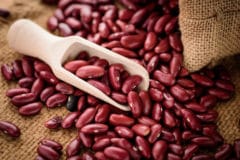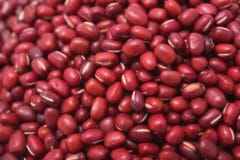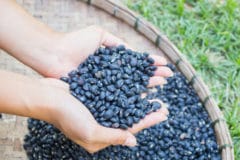About Mung Beans
The mung bean originated in Persia (now called Iran) and gradually spread throughout the Middle and Far East. The beans are more closely related to cowpeas than regular green beans, and both pods and the beans themselves look like cowpeas. A good source of protein, mung beans are used in paste form as well as fresh and dried for both sweet and savory dishes.
About Bean Sprouts
Bean sprouts are the root, residual bean seed and first set of leaves from the sprouting seed. In most cases, they are grown indoors and used when they are only a few days old, so that no color has developed in the sprout. However, they may also be grown in trays or even the soil and exposed to light. The entire sprout is eaten.
Growing Mung Beans for Sprouting
Mung beans are typical beans in that they are warm weather plants. They should be planted after the danger of frost is past and the soil has warmed. Mung beans need only average garden soil and regular watering – about one inch or more per week. They do not require a trellis. Most varieties are mature in about 100 days after sowing.
Mung Bean Varieties
Although there are a number of varieties, you may have to search to find different varieties to grow:
- Berken – green seeded, produces large sprouts.
- Crystal – heavy yielding, a cross between several bean varieties.
- Reselected Emerald – similar to Berken but has harder seeds that don’t sprout as well.
- Satin II – good disease resistance and heavy yields.
- Regur – grows better under wet conditions.
Storing Mung Beans
Mung beans must be completely mature and dry for best storage. Pull the plants once the pods are mature and have started to dry. Then hang from the rafters in a warm, dry room or building. Spread papers underneath to catch seeds that fall. Allow to dry completely, then thresh from their hulls, store in air-tight containers or freeze the beans.
Sprouting with a Tray
Trays specifically designed to sprout beans are readily available or you can make your own from a plastic deli tray with holes punched in the bottom. Rinse the seeds, remove any debris, and the soak the seeds in cool water for about eight hours. Drain and repeat the process for two or three days. Spread seeds in the tray, misting daily for about three days, when they should be ready to eat.
Sprouting in Soil
Although traditional mung bean sprouts are white or pale yellow, you can also sprout them in soil and expose them to sunlight or grow lights. This will give them a green color and more nutrients. Prepare a box or tray with about six inches of soil. Plant beans one inch deep. When the sprouts have grown to about two or three inches in height, cut them off with sharp scissors.
Sprouting with a Jar
A quart jar makes a good environment for sprouting mung beans. Replace the lid with a piece of mesh cloth or screening. Soak the beans overnight, then drain and rinse. Drain completely. Place the jar on its side in a warm, dark area. Remove the jar lid, rinse and drain the beans daily for five to seven days. The beans can be exposed to light for a few days if you want green sprouts.
Storing Sprouted Beans
The idea behind sprouting beans is to eat them at their freshest, but they can be stored. After the final rinse, drain them completely then let them sit on paper towels for an hour or so. Place them in plastic bags, seal the bags, and store in the refrigerator for three days maximum. The sprouted beans cannot be frozen.
Using Sprouted Mung Beans
Many Oriental recipes make use of sprouted beans in stir fries. Meats may include pork, beef or chicken, as well as fish and shellfish, mixed with a variety of other vegetables. Beans sprouts are often added to egg foo yung. Koreans boil the beans until crisp-tender, chill and serve as a salad with green onions, soy sauce, herbs and spices. The sprouts may also be sauteed as you would any vegetable.
